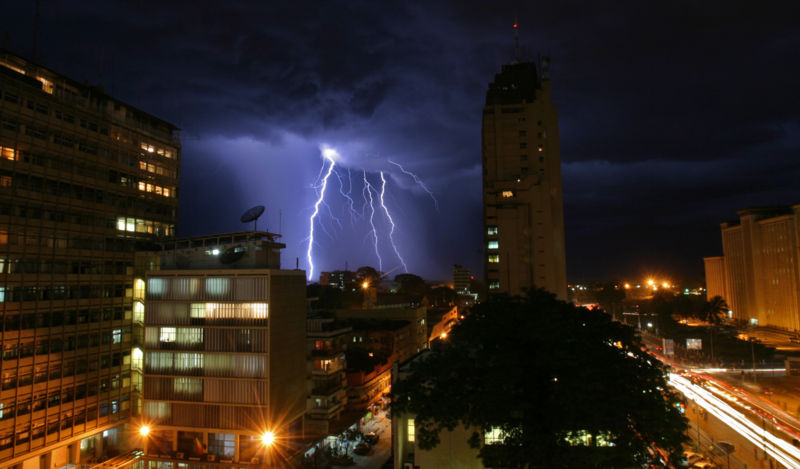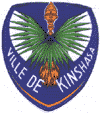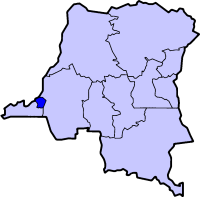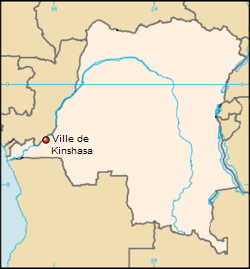Kinshasa
From Roach Busters
| Ville de Kinshasa (formerly Léopoldville) | |
| | |
 Skyline of Kinshasa | |
| | |
 | 
|
| Flag | Seal |
| | |
| Nickname Kin la belle (French) ("Kinshasa the beautiful") | |
| | |
 Map of Zaire highlighting the city-province of Kinshasa | |
| | |
 Map of Zaire highlighting the city-province of Kinshasa Coordinates: 4°19′30″S 15°19′20″E | |
| | |
| Country Province | Kinshasa |
| | |
| Administrative HQ Communes Largest commune | La Gombe 24 Maluku |
| | |
| Governor | Mungul Yezu |
| | |
| Area - City-province | 9,965 km² 3,847.5 sq mi |
| | |
| Population (2004) - City-province - Density - Metro - Language | 7,017,000 704/km² 1,823.4/sq mi 9,000,000 (incl. Brazzaville) Lingala |
| | |
| Website | http://www.kinshasa.cd |
Kinshasa is the capital and largest city of Zaire. It and Brazzaville, capital of the Republic of the Congo, are on opposite sides of the Zaire River. It is a huge, sprawling city, teeming with over 7 million people, and is vibrant and colorful both day and night. It is a city of sharp contrasts, where posh suburbs lie side to side with impoverished shantytowns, where magnificent mansions and glittering skyscrapers tower over overcrowded hovels. Mercedes Benz and carriages, millionaires and beggers, abound. It and Johannesburg are tied for second largest city in sub-Saharan Africa, with Lagos being the largest. The city is famous (or perhaps, infamous) for its poor hygiene and massive mounds of garbage everywhere, which have caused denizens to derisively dub the city Kin la poubelle (poubelle is French for garbage). Crime, too, has earned the city an unsavory reputation. Residential break-ins, carjackings, muggings, and street crimes of all sorts are endemic. Some of the more dangerous slums make war zones look like flower gardens in comparison.
The city was originally called Léopoldville, after Belgium's King Léopold II. Founded in 1881 by Henry Morton Stanley (for whom Stanleyville, later called Kisangani, was named), it began life as a trading post, but quickly blossomed into a thriving city. It was the first navigable port along the Zaire River above Livingstone Falls, it achieved great commerical significance. Prior to the city's construction, transportion of goods from the interior of the Belgian Congo (as Zaire was then known) was a much longer process, as the goods had to be carried by porter to the port of Matadi, along the coast. In 1898, a new railroad was built, providing a viable means of transportation along the Zaire River's lower reaches, causing the significance and prestige of the city to grow greater still. The city grew at a rapid place, and eventually achieved such prominence that it became the capital of the Belgian Congo in the year 1920. After Mobutu Sese Seko came to power in the 1960s, he subsequently christened the city Kinshasa, a name it has retained to this day.
Over the years, the city has continued to grow, to the point where it now has a whopping 6.5 million population, and is growing bigger by the day. Parts of the city were badly damaged during bloody riots and widespread looting by unpaid soldiers in 1991 and 1993. While a fragile peace has been sustained since then, pockets of lawlessnes still persist in Kinshasa, and continuing economic difficulties compound the city's already alarming crime rate. The vast majority of Kinshasa's citizens are quite poor and survive on one meal a day. As such, malnutrition is rife, and many people are forced to resort to petty crime to feed their families and stay alive.
Kinshasa almost never receives any tourists anymore, but those who do can find it a positive experience, provided they observe strident safety measures and maintain a positive attitude. Attractions include museums, a fine arts academy, two universities, the Sozacom (a state-owned mining company) building, and thriving markets. The Intercontinental Hotel is the most popular place to stay for foreign visitors.
